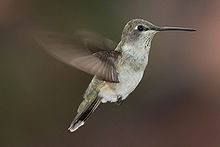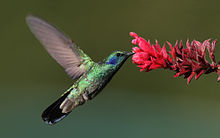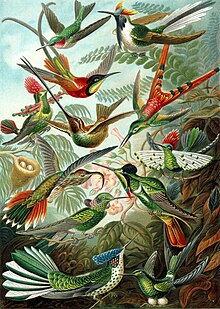
Hi Everybody!
Yes, I would bet on the Hummers against any of NASA's fancy jets! Every year the birds have more flight time than any human Pilot. The short time they spend at Kates Cabin every year is similar to a "Summer Camp" for kids. They use this time to sharpen all competitive skills with the interaction of each other and the bees over the nectar feeders. I have never seen a bird killed by another bird or any eyes poked out. They defend territory by day, but at the end of the day, they all sit together and eat, then all sleep in the trees close to each other. They travel in small groups. I feel the information that these birds are loners is incorrect as they are very social that I observe and document. I encourage You all to make your own observations and post them for consideration by the Scientists. Many things are yet to be revealed about our wonderful world! Get Involved! If You look, You will see!!! Enjoy!

The Following is an excerpt only. Please visit link for complete article:
https://en.wikipedia.org/wiki/Hummingbird
Hummingbird
From Wikipedia, the free encyclopedia
| Hummingbird | |
|---|---|
 | |
| Female Black-chinned Hummingbird | |
| Scientific classification | |
| Kingdom: | Animalia |
| Phylum: | Chordata |
| Class: | Aves |
| Subclass: | Neornithes |
| Infraclass: | Neognathae |
| (unranked): | Cypselomorphae |
| Order: | Apodiformes |
| Family: | Trochilidae Vigors, 1825 |
Diet and specialization for food gathering
Hummingbirds drink nectar, a sweet liquid inside certain flowers. Like bees, they are able to assess the amount of sugar in the nectar they eat; they reject flower types that produce nectar that is less than 10% sugar and prefer those whose sugar content is higher. Nectar is a poor source of nutrients, so hummingbirds meet their needs forprotein, amino acids, vitamins, minerals, etc. by preying on insects and spiders.[5]
Most hummingbird species have bills that are long and straight or nearly so, but in some species the bill shape is adapted for specialized feeding. Thornbills have short, sharp bills adapted for feeding from flowers with short corollas and piercing the bases of longer ones. The Sicklebills' extremely decurved bills are adapted to extracting nectar from the curved corollas of flowers in the family Gesneriaceae. The bill of the Fiery-tailed Awlbill has an upturned tip, as in the Avocets. The male Tooth-billed Hummingbird has barracuda-like spikes at the tip of its long, straight bill.
The two halves of a hummingbird's bill have a pronounced overlap, with the lower half (mandible) fitting tightly inside the upper half (maxilla). When hummingbirds feed on nectar, the bill is usually opened only slightly, allowing the tongue to dart out and into the interior of flowers.
While it had been believed that hummingbirds drink via capillary action, high-speed photography has revealed that a hummingbird's tongue’s tubes open down their sides, and close around nectar.[6] Hummingbirds do not spend all day flying, as the energy cost would be prohibitive; the majority of their activity consists simply of sitting or perching. Hummingbirds eat many small meals and consume as much as twelve times their body weight in nectar each day.[7] Hummingbirds digest their food rapidly due to their small size and high metabolism; a mean retention time (MRT) of less than an hour has been reported.[8] Hummingbirds spend an average of 10–15% of their time feeding and 75–80% sitting and digesting.
Hummingbirds are typically very territorial when it comes to food; once a hummingbird finds a consistent source of food such as an artificial feeder, it will fight off other hummingbirds to maintain complete dominance over the food source.
Migration
Most hummingbirds of the U.S. and Canada migrate south in fall to spend the winter in northern Mexico or Central America. A few southern South American species also move to the tropics in the southern winter. A few species are year-round residents in the warmer coastal and southern desert regions on the USA. Among these is Rufous Hummingbird, a winter resident in Florida, parts of the Gulf coast, and up to the lowlands of coastal South Carolina/Georgia, and Anna's Hummingbird, a common resident from California inland to southern Arizona and north to southwestern coastal British Columbia.
The Rufous Hummingbird is one of several species that breed in North America and are wintering in increasing numbers in the warm subtropical southeastern United States, rather than in tropical Mexico. The Rufous Hummingbird nests farther north than any other species and must tolerate occasional temperatures below freezing on its breeding grounds. This cold hardiness enables it to survive brief temperatures below freezing, provided that adequate shelter and feeders are available.
Feeders and artificial nectar
Hummingbirds will also take sugar-water from bird feeders. Such feeders allow people to observe and enjoy hummingbirds up close while providing the birds with a reliable source of energy, especially when flower blossoms are less abundant.
White granulated sugar is the best sweetener to use in hummingbird feeders. A ratio of 1 cup sugar to 4 cups water is a common recipe.[37] Boiling and then cooling this mixture before use has been recommended to help deter the growth of bacteria and yeasts. Powdered sugars contain corn starch as an anti-caking agent; this additive can contribute to premature fermentation of the solution. Brown, turbinado, and "raw" sugars contain iron, which can be deadly to hummingbirds if consumed over long periods.[38] Honey is made by bees from the nectar of flowers, but it is not good to use in feeders because when it is diluted with water,microorganisms easily grow in it, causing it to spoil rapidly.[39][40][41]
Red food dye is often added to homemade solutions. Commercial products sold as "instant nectar" or "hummingbird food" may also contain preservatives and/or artificial flavors as well as dyes. The long-term effects of these additives on hummingbirds have not been studied, but studies on laboratory animals indicate the potential to cause disease and premature mortality at high consumption rates.[42] Although some commercial products contain small amounts of nutritional additives, hummingbirds obtain all necessary nutrients from the insects they eat. This renders the added nutrients unnecessary.[28]
Other animals also visit hummingbird feeders. Bees, wasps, and ants are attracted to the sugar-water and may crawl into the feeder, where they may become trapped and drown. Orioles, woodpeckers, bananaquits, and other larger animals are known to drink from hummingbird feeders, sometimes tipping them and draining the liquid.[43] In the southwestern United States, two species of nectar-drinking bats (Leptonycteris yerbabuenae and Choeronycteris mexicana) visit hummingbird feeders to supplement their natural diet of nectar and pollen from saguaro cacti and agaves.[44]

Thanks to the guys at G+Awesome AutoBackup we have highlights of the September 7 photostudy and a smile!




To view the complete photostudy in my albums with the slideshow option, click on link below and off You go! Enjoy!
Link to September 7, 2013 Album at my G+ Photo Albums:
https://plus.google.com/u/0/photos/117645114459863049265/albums/5926088720525207873?partnerid=gplp0

...this is brendasue signing off from Rainbow Creek. See You next time! I hope You are enjoying viewing the photostudies in the G+Albums. I will be posting everyday of the migration. Just telling You now: One day soon the tiny birds will just be gone and there will be no more photo ops until next August. That's how it is-They just fly away to Mexico every year. Now they will always be in the Albums, recorded time in History.
So enjoy while they are here!


O+O





No comments:
Post a Comment
Hi Everybody! Please say hello and follow so I know you are here! Due to the inconsideration of people trying to put commercials on my blog comment area, I have restricted use of anonymous posts. Sorry that some hurt all.
My public email is katescabin@gmail.com No spammers or trolls